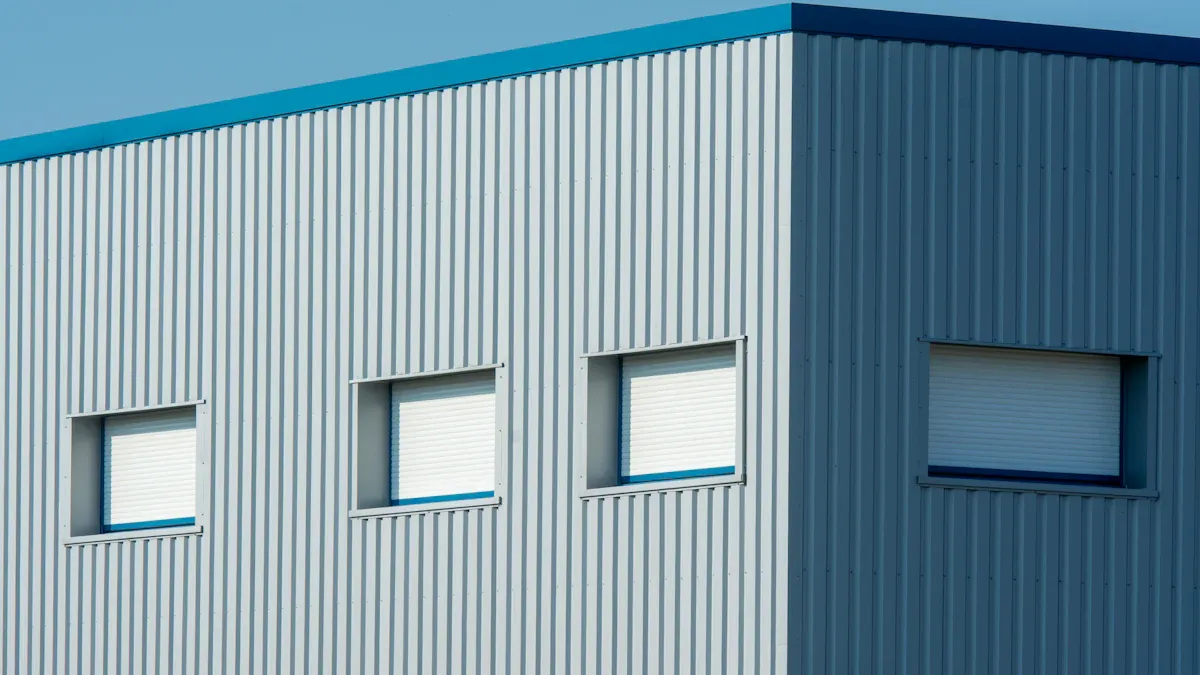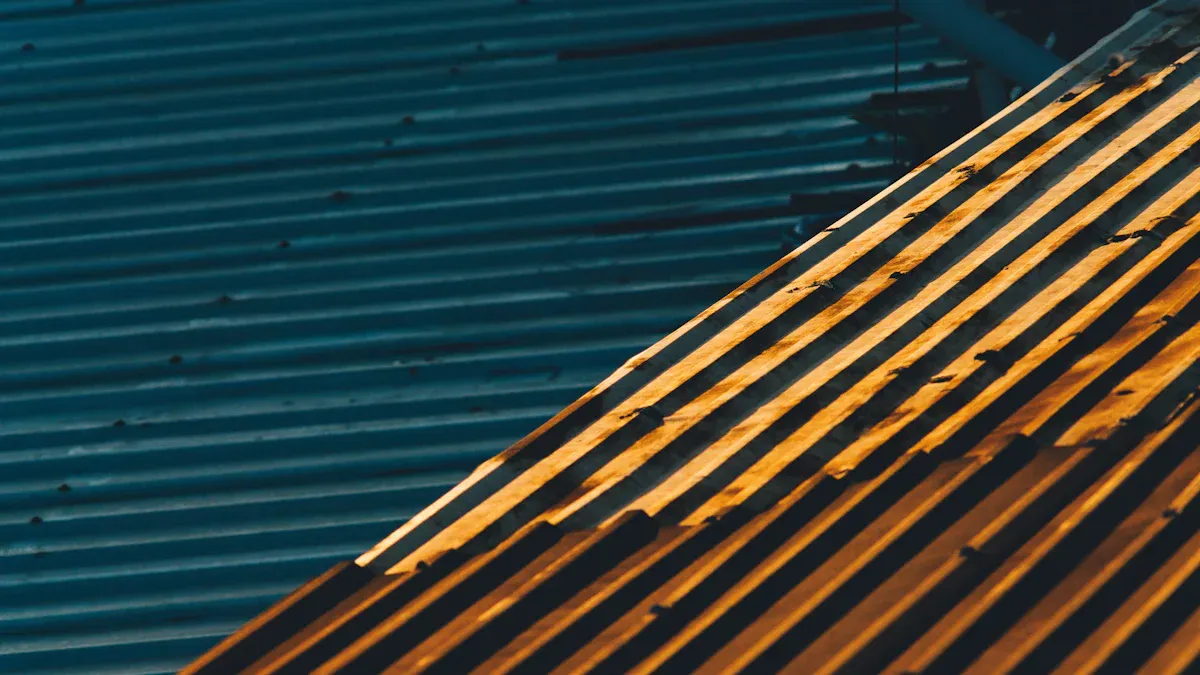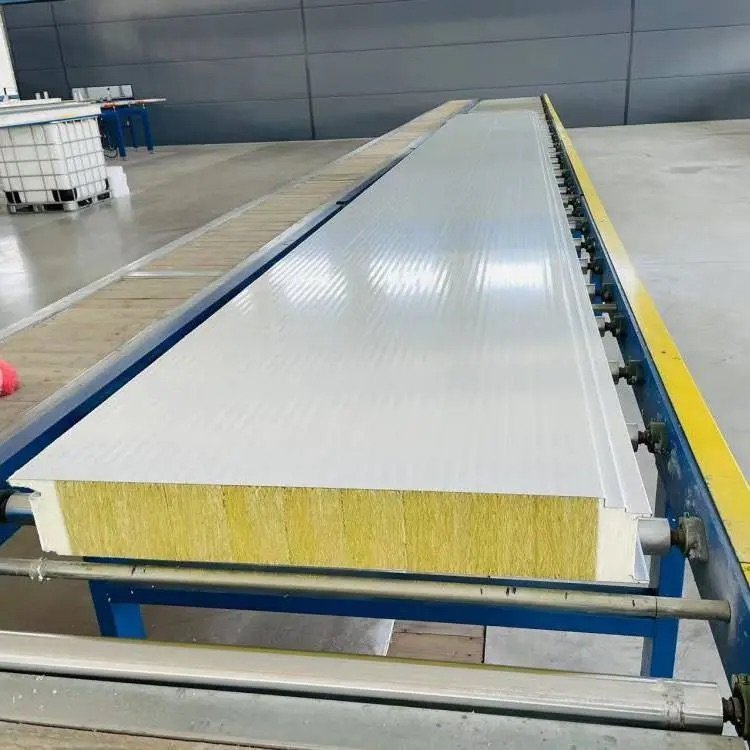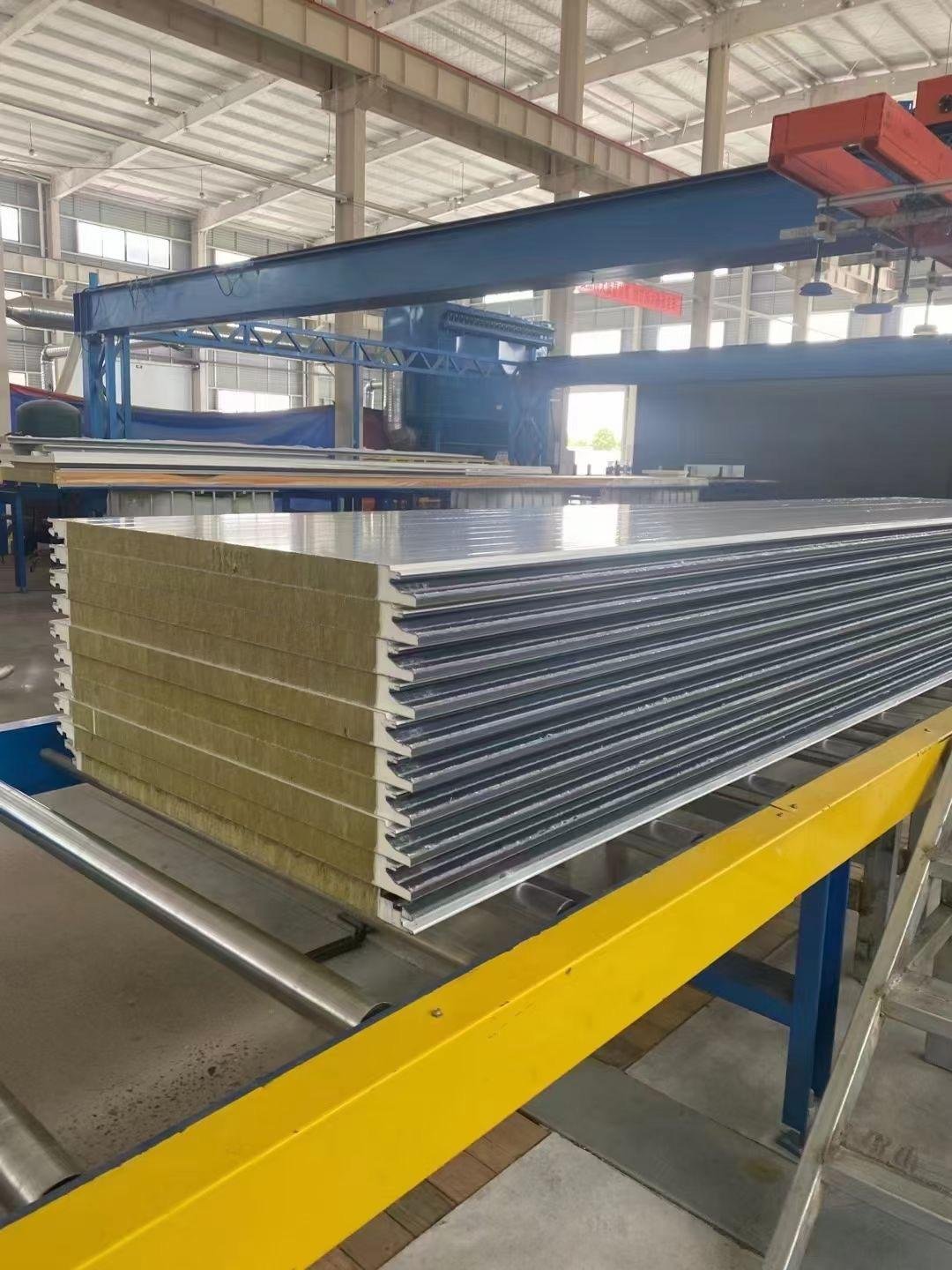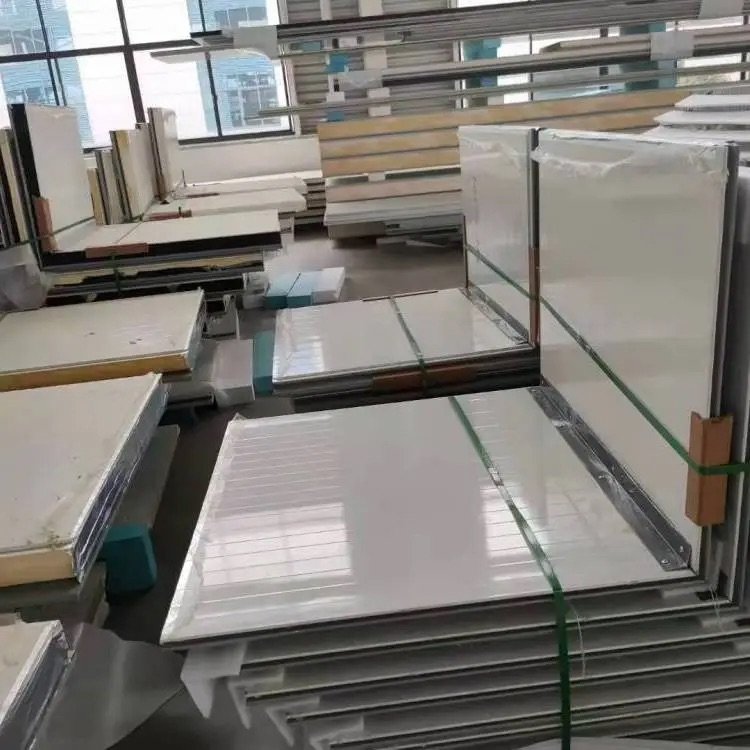
Picking the right sandwich panel for hot areas keeps things safe. High heat can weaken insulation and fire protection, causing risks. For example, panels with special shear connections block more heat. They allow only 127 W/m² of heat compared to 276 W/m² in regular panels. This shows why strong materials are important for handling heat. Good panels absorb less heat and stay strong in tough conditions. Using approved materials makes things safer and lasts longer.
Key Takeaways
Pick panels with tough cores like mineral wool or foam for fire safety and insulation.
Find panels with high R-values to save energy and keep temperatures steady in hot places.
Use special glues and fasteners made for heat to keep panels secure.
Talk to experts to choose the right panel for your needs and follow safety rules.
Focus on strong and fire-safe panels to avoid repairs and improve performance over time.
Types of Sandwich Panels

Metal-Faced Sandwich Panels
Metal-faced sandwich panels are often used in hot areas. They are made with materials like aluminum and steel. Aluminum is light and does not rust easily. This makes it great when weight is important. Steel is strong and can handle impacts, making it very durable.
To make them better, these panels get special coatings. These coatings protect them from weather and make them last longer. You will see these panels on roofs and walls of factories and offices. They stay strong under heat and keep their shape.
Composite Sandwich Panels
Composite sandwich panels work well in hot places because of their features. They have a core, like phenolic resin, and tough outer layers.
Feature | Description |
|---|---|
Thermal Insulation | Keeps heat out, saving energy and lowering emissions. |
Fire Resistance | Resists fire, good for places with fire risks. |
Construction Speed | Quick to install, useful for business buildings. |
The core material in these panels blocks heat with values between 0.020 and 0.025 W/m-K. They also meet strict fire safety rules, like fire class A, which means they resist heat and don’t release harmful smoke. These panels are strong and work well in wet or changing temperatures, needing less fixing over time.
Specialty Sandwich Panels for High-Temperature Applications
Specialty sandwich panels are made for very tough conditions. Regular panels might not work in these situations. These panels are tested to meet safety and performance rules. For example, the ISO 13784-1 test checks how they handle fire. The EN 13501-1 standard looks at fire behavior to ensure they follow laws.
These panels often use advanced materials like titanium or strong steel in their cores. This gives them great heat and fire resistance. They are used in places like industrial ovens or areas with flammable items. They can handle extreme heat, keeping things safe and lasting a long time.
Key Selection Criteria for the Right Sandwich Panel
Core Materials
Mineral Wool
Mineral wool is a top pick for hot areas. It keeps heat out and stays stable up to 300°C. This makes it great for stopping fires. It works well in places like power plants and chemical factories. It is strong enough to last and insulates very well.
PIR (Polyisocyanurate)
PIR is light and saves energy while blocking heat. It also resists fire, making it safe to use. It is often used in cold storage and workshops. These panels keep temperatures steady and work efficiently.
Phenolic Foam
Phenolic foam is great at stopping fires and keeping heat out. It meets strict fire safety rules, making it very reliable. It is light and works well in tough conditions. This makes it a good choice for fire-safe walls in fancy buildings.
Material | Heat Insulation | Fire Safety | Strength | Best Uses |
|---|---|---|---|---|
Mineral Wool | Great | Normal | Medium | Power plants, chemical factories |
PIR | Great | Good | Good | Cold storage, workshops |
Phenolic Foam | Great | Great | Medium | Fire-safe fancy buildings |
Facing Materials
Steel and Aluminum
Steel and aluminum are common panel covers. Steel is strong and handles hits well. Aluminum is light and does not rust. Both help panels resist fire and meet safety rules.
Special Materials for Tough Conditions
For very hot places, special materials like titanium are used. These materials handle heat and stay strong. They are used in factories needing fire-safe and long-lasting walls.
Fire Resistance
Fire Ratings and Tests
Fire safety is very important for panels. Tests like ISO 13784-1 and EN 13501-1 check how materials handle fire. These tests ensure panels are safe and work well in hot areas.
Test Name | What It Checks |
|---|---|
ISO 13784-1:2014 | Tests how panels handle fire. |
EN 13501-1:2019 | Rates how materials behave in fire. |
EN 13823:2020 | Checks fire safety of building products. |
UNE-EN 14509:2014 | Sets rules for making safe insulated panels. |
Why Non-Combustible Materials Matter
Non-combustible materials are key for fire safety. Materials like mineral wool and phenolic foam resist fire well. They stop fires from spreading and make panels safer to use.
Thermal Insulation
R-Value and Energy Efficiency
R-value shows how well a panel blocks heat. Higher R-values mean better insulation and energy savings. For example:
Panel P0 has a resistance of 1.09 m²K/W.
Panel P2 improves to 1.73 m²K/W.
Panel P3 reaches 2.43 m²K/W.
Panel P4 is the best at 2.48 m²K/W.
Panels with R-values from 1.5 to 7 insulate well. An R-value of 7 is great for keeping temperatures steady. These panels are perfect for cold storage, where stable temperatures matter. Choosing high R-value panels saves energy and keeps spaces efficient.
How Thickness Affects Performance
Thicker panels block heat better than thinner ones. They reduce heat transfer and improve insulation. A thicker core helps keep water and air out. This is important for places like cold storage. Thicker panels also help control temperatures better. They are a smart choice for factories and offices.
Durability
Handling Heat Stress
Panels must handle heat stress to last long. Tests show staggered panels like P2, P3, and P4 transfer less heat (174 W/m², 128 W/m², and 127 W/m²) than P0 (276 W/m²). Less heat transfer means they handle stress better. Panels that reduce thermal bridges stay strong in tough conditions.
Lasting in Hot Areas
Durable panels are key for hot places. Materials like mineral wool and phenolic foam resist fire and last longer. They keep their shape even after years of heat. Good insulation also reduces damage from temperature changes. This makes them reliable and cost-saving over time.
Material Comparison of Sandwich Panels

Mineral Wool
Mineral wool is great for keeping heat out and stopping fires. It stays strong even in very hot places, like power plants and chemical factories. Because it doesn’t burn, it’s very safe for hot areas. It also resists water, so it works well for a long time.
Compared to materials like EPS or PU, mineral wool is better at handling fire and lasts longer. For example:
Material | Thermal Insulation | Fire Resistance | Strength | Applicable Scenes |
|---|---|---|---|---|
Rock wool | Excellent | Normal | Medium | Chemical plants, power stations |
PU | Excellent | General | Good | Cold storage, workshops |
EPS | Average | Average | Average | Temporary buildings, workshops |
This table shows why mineral wool is a smart pick for walls in tough places.
PIR (Polyisocyanurate)
PIR panels save energy and stop fires well. They are light but strong, making them perfect for cold storage and workshops. These panels keep temperatures steady, which lowers energy bills.
PIR panels don’t melt in fire; they form a char layer. This slows down flames, making them safer for risky areas. Their strength and flexibility make them a top choice for walls in factories and offices.
Phenolic Foam
Phenolic foam is the best at stopping fires and keeping heat out. It has a Class A fire rating, meaning it makes little smoke and burns slowly. It stays strong even in heat over 200°F.
Here’s how phenolic foam compares to other materials:
Property | Phenolic Foam Panels | Other Insulation Materials |
|---|---|---|
Fire Resistance | Lower fire resistance, higher smoke | |
Flame Spread | Slow flame spread | Faster flame spread |
Temperature Integrity | Maintains integrity above 200°F | Degrades at lower temperatures |
Thermal Conductivity | Low thermal conductivity, high efficiency | Higher thermal conductivity |
Phenolic foam is a great choice for fire-safe buildings. It combines safety and energy savings, making it ideal for important projects.
Specialty Core Materials (e.g., Titanium, Steel)
Specialty core materials like titanium and steel work great in very hot places. They are strong and last long, even in tough jobs. These materials are used in industries like petrochemicals, metal-making, and water cleaning. They are perfect where heat and strength are very important.
Titanium is light but super strong. It does not rust and stays solid in high heat. This makes it a good pick for places with heat and chemicals. For example, titanium fiber felts filter well even in extreme heat. Their detailed design helps them work efficiently in hot conditions. This makes them useful for special sandwich panels.
Steel, especially stainless steel like 316, is also a great choice. It handles heat and stays strong without bending or breaking. This makes it good for jobs needing long-lasting materials. It also works well in places where temperatures change a lot.
These materials make sandwich panels stronger and last longer. Picking titanium or steel cores means your panels can handle hard jobs and stay reliable. Whether for industrial ovens or risky areas, these materials give you safety and efficiency.
Tip: Talk to experts to pick the best core material for your needs. The right choice can make your project safer and better.
Installation Considerations for Sandwich Panels
Challenges in High-Temperature Environments
Handling and Storage
Handling and storing sandwich panels in hot areas can be hard. Panels must stay undamaged to work well. If the metal skin gets damaged, fire resistance weakens. For example, a punctured metal skin makes panels less safe in heat. Bad storage can cause bending or damage, especially in extreme heat.
Another problem is installing fire-stopping items like cable trays. If done wrong, they can let harmful gases pass through, reducing safety. Real fires often produce more heat than test conditions. This makes proper handling and storage even more important.
Challenge Description | Impact on Installation Process |
|---|---|
Poor fire-stopping for through-panel installations (e.g., cable trays) | Creates paths for harmful gases, lowering fire safety. |
Damage to the metal skin of panels during handling | Makes panels weaker in high heat, reducing fire protection. |
Real fires producing more heat than test conditions | Causes panels to perform worse in real-life situations. |
Different needs for big buildings versus small test rooms | Rushing installations can lead to mistakes and risks. |
Ensuring Proper Sealing and Joint Integrity
Seals and joints are key for keeping panels safe and effective. Heat can make seals shrink or stretch, creating gaps. These gaps let heat and smoke pass through, making panels less useful. Tight seals and good alignment during installation stop these problems. Use materials that stay strong in high heat without breaking down.
Solutions for Effective Installation
Specialized Fasteners and Adhesives
Using the right tools helps panels stay secure and strong. In hot areas, special adhesives like epoxy or PVC work best. They stick well and resist heat. Thread lockers are also great for keeping screws tight and stopping them from loosening.
Some adhesives weaken in extreme heat. Choose heat-resistant ones like LORD 305 epoxy adhesive for better results.
Here are some good options:
PVC Adhesives: Great for connecting pipes and PVC parts.
Epoxy Adhesives: Strong and reliable for construction projects.
Thread Lockers: Keep screws tight and stop them from shaking loose.
Tile Adhesives and Grout: Help with neat tile installation indoors and outdoors.
Importance of Professional Installation Teams
Experts make installation safer and better. They know how to handle challenges in hot areas and follow rules carefully. Professionals use advanced tools to keep seals tight and joints strong. Hiring skilled teams lowers mistakes and ensures panels work as they should.
Case Studies: Picking the Right Sandwich Panel
Industrial Uses
Example: Factory with Mineral Wool Panels
Factories need to stay safe and work well. Mineral wool panels are great because they resist fire and handle heat. For instance, a warehouse used PU wall panels to improve its setup.
Feature | Description |
|---|---|
Use | |
Heat Efficiency | Keeps goods at the right temperature |
Toughness | Stays strong even with constant use |
Worker Comfort | Reduces noise and keeps temperatures steady for better comfort |
Work Impact | Boosts worker happiness and job performance |
These panels last long and work well, even in hot places. They also make workers more comfortable by cutting noise and keeping temperatures steady. This makes them a smart pick for factories.
Business Uses
Example: Kitchen with PIR Panels
In clean food spaces, PIR panels are the best choice. They block heat and resist fire, keeping things safe and saving energy. Kitchens like these panels because they keep temperatures steady and meet hygiene rules.
PIR panels also stop water, so they’re great for clean areas. They are light and easy to install, saving time in busy places. Using PIR panels helps create a safe and clean workspace that follows the rules.
Home Uses
Example: House with Phenolic Foam Panels for Fire Safety
Phenolic foam panels are ideal for homes where fire safety matters. They burn slowly and make little smoke, keeping families safer.
A tall office building in New York used these panels to follow fire laws, proving their trustworthiness.
These panels also keep homes warm or cool, saving energy.
By choosing phenolic foam panels, you can make your home safer and more energy-efficient while staying comfortable.
Picking the right sandwich panel for hot areas keeps things safe. Focus on important factors like core materials, fire safety, insulation, and strength. These features help panels stay strong and protect from heat damage.
Talk to experts who know your needs to choose wisely. Always pick certified materials that follow safety rules. This ensures the panels work well and keep you worry-free in tough conditions.
Tip: Choosing the right sandwich panel now can prevent expensive fixes and safety problems later.
FAQ
What makes a sandwich panel good for hot areas?
The core and outer materials decide how it performs. Pick cores like mineral wool or phenolic foam for fire safety. Use strong outer layers like steel or aluminum. These materials help the panel handle heat and stay safe.
How is a sandwich panel’s insulation measured?
Insulation is checked using the R-value. Higher R-values mean better insulation. For instance, panels with R-values over 2.0 m²K/W save energy and control heat well in hot places.
Can sandwich panels stop fires from spreading?
Yes, panels with cores like mineral wool or phenolic foam resist fire. Look for certifications like EN 13501-1. These prove the panel slows fire and reduces smoke.
Are thicker panels always better for heat?
Not always. Thicker panels insulate better but may not fit all needs. Think about your space, budget, and insulation goals. Cold storage benefits from thick panels, but regular walls might not need them.
Do sandwich panels need special setup in hot places?
Yes, proper sealing and heat-proof adhesives are key. Hire experts to ensure tight joints and strong fasteners. This stops gaps that could weaken insulation and fire protection.
Tip: Always ask experts to find the right panel for your hot area needs.

